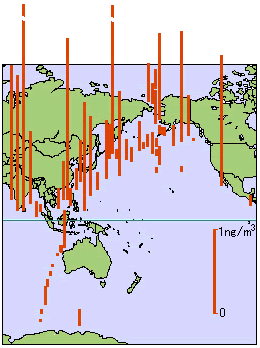PCB pollution was once considered a problem
of developed countries that have massively produced and
used PCBs. However, recent surveys indicate that nations
in the torrid zones of lower latitudes are also being
polluted. One reason for this pollution is the export
of PCB-polluted products from developed countries to the
developing world. Exported products are still being used
and some of them are discarded in inappropriate ways.
PCB pollution is no longer a problem that can be addressed
by the efforts of one single nation. Now, worldwide cooperation
is required.
A survey of the year-to-year changes in the concentrations
of PCBs in the environment indicates that there was a
peak in the 1970s, and then after that, concentrations
began to decline following the ban on production. Concentrations
are still declining, but at a slower pace compared to
other organo-chlorine pesticides. A monitoring report
on mink whales in the Antarctic Ocean shows that concentrations
have not changed in the past 10 years, but rather have
shown a tendency to increase. This suggests that pollution
sources have not yet been completely removed and also
indicates that PCBs are very slow to decompose.
Once PCBs are emitted into the natural environment, it
takes a very long time for them to decompose. We must
not allow any more release of PCBs into the environment.
|
Worldwide PCB Pollution of Air
 |
Comparison of concentration of PCB in Various Environmental
Compartments in India, Australia, and Bering Sea during 1988-1992
 |
 |
 |
 |
 |
Media
|
Unit
|
Area
|
|
 |
India
(1988-1989)
|
Australia
(1990-1992)
|
Bering
Sea
(1989-1992) |
 |
 |
 |
 |
 |
Air
|
pg/m3
|
1600
|
8400
|
93 |
Water
|
pg/L
|
16700
|
500
|
12 |
| Agriculture soil |
ng/g |
NA
|
36
|
|
Sediment
|
ng/g
|
270
|
110
|
0.13 |
Fish
|
ng/g
|
3.5
|
55
|
7.2 |
 |
 |
 |
 |
 |
|
NA: Not available
K. Kannan et al., (1995) Environ. Sci. Technol. 29, 2673-2683
|
